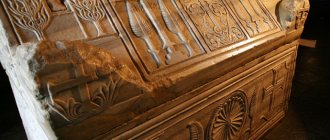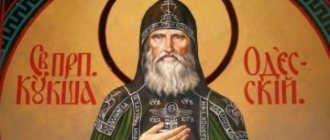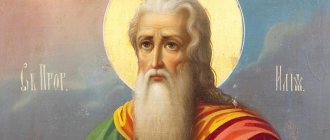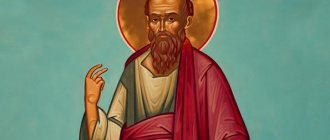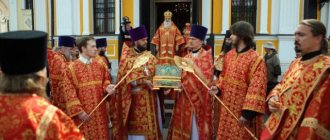People who feel a special connection with God sometimes choose a difficult path in life - monasticism. However, becoming a monk is not at all easy. You need to pass a series of tests to receive the highest degree of monastic tonsure.
Ryasophorus, the small and great schemas are the three stages of monasticism that the Orthodox Church distinguishes. The highest degree of monasticism in Orthodoxy is vesting in the great schema. If they talk about it without specifying it, then it means just great. Many people far from monastic life would like to know who schemamonks are.
Monastic schema: what is it?
Believers of the Orthodox Church are divided into clergy (clergy) and laity. A separate category consists of monks, who differ from both. Monasticism is not a priesthood; monks are not always priests. Those who accepted monasticism are also called monks, that is, leading a different way of life. Some monks are called schemaniks. In this regard, questions often arise: what is a schema? Who are the schema-monks? How do they differ from the monastic brethren? And in general, what is the monastic schema?
Orthodox monk in the vestments of the great schema
Entry onto the monastic path
When a layman comes to the idea that his future path in life should pass within the walls of a monastery, he makes a request to the abbot of the monastery he has chosen, and he, if he sees no obstacles to this, gives him a chance to test his readiness to renounce everything worldly for the sake of saving his soul and gaining eternal life. Future schema-monks are people who, first of all, have deep humility, so they, regardless of their age and position in worldly life, humbly bow their heads before the need to become temporarily disciples and younger brothers of other monks.
Skhemnik - who is this?
Each Christian independently chooses his own path to spiritual salvation. This can be married life in a Christian marriage, or a chaste, celibate life (monasticism).
Monasticism took shape as a separate type of Christian life in the 4th century in Egypt. The appearance of the first monastic communities dates back to this time. Their participants led a lifestyle that differed from the behavior of other believers. The differences between these hermits related to both internal changes (constant prayer, humility) and external attributes (for example, the special robe of a monk). In Greek, "schima" means "image." Initially, this concept applied only to clothing. Over time, monasticism itself began to be called schema. Therefore, a schema-monk is a monk who has taken vows (promises) of obedience, non-covetousness and chastity.
“Monasticism, by its design, is an imitation of the way of life of Christ. The Gospel Christ reveals itself to us as the ideal of a perfect monk: He is unmarried, free from family attachments, has no roof over his head, wanders, lives in voluntary poverty, fasts, and spends his nights in prayer. Monasticism is the desire to get as close as possible to this ideal, the striving for holiness, for God, the renunciation of everything that keeps one on earth and prevents one from ascending to heaven. Loneliness is incompleteness, inferiority; in marriage it is overcome by finding another. In monasticism, this other is God Himself” (Metropolitan Hilarion Alfeev of Volokolamsk).
History of monasticism
In the old days, schema-monks were called hermits or hermits, since they first lived in the desert. In the 5th century, hermitage gave way to seclusion, and monks began to live in monasteries. But over time, seclusion ceased to be a prerequisite for schema training. It was possible to distinguish a schemanik by his clothes, which is why the name “schema” referred specifically to clothing. Subsequently, vows were added to clothing and an ascetic lifestyle.
Nowadays, the Great Skhemnik can be distinguished by a special pointed cap called a kukol.
The first monks appeared in Syria and Egypt in the 4th and 3rd centuries AD. The goal of monasticism was to gain salvation through life in Christ
. The first Christians literally understood the commandments of Christ and the instructions of the apostles, therefore they completely renounced worldly vanity. According to the first Christians, the world is filled with evil, and the source of evil is the mortal body. It is the body that succumbs to numerous temptations that can be overcome by fasting and prayer.
The monk took vows:
- non-covetousness (poverty);
- chastity (celibacy);
- obedience (renunciation of one's own will).
Vow of non-covetousness
involves the complete renunciation of any property. The monk does not even own a writing pen, he has nothing. This is a voluntary renunciation of all the things of the world because they become unnecessary. This is the loss of all interest in earthly things due to their uselessness. The monk uses things only when absolutely necessary.
Celibacy
does not simply imply a refusal to live together with a spouse, but a denial of gender in general. That is, for a person, only the soul matters, and it has no gender.
Vow of obedience
means that a person no longer has his own desires. There remains only one desire - to constantly be with the Lord. In monastic life, the vow is realized in unquestioning obedience to the abbot of the monastery. However, unquestioning obedience does not imply resigned obedience against one's own will, but joyful service.
The first monks went into caves or deserted places to live away from worldly temptations. Over time, they began to form monastic communities - monasteries. They accepted new members of the community and put them through trials to test their commitment to life in Christ. The tests required complete obedience and renunciation of one's own will.
Degrees of monasticism
In the Orthodox Church, monasticism is divided into the ryasophore and the schema.
A cassock monk (from Greek - “wearing a cassock”) is a novice. When initiating a ryassophore, certain prayers are read and hair is cut crosswise. However, those initiated into the ryassophore do not take monastic vows, and they do not always even change their name. From the moment of tonsure, the ryassophore monk prepares to accept the schema.
In Russian Orthodoxy, the lowest and highest degrees of schema are distinguished: small (mantle) and great. But if we are talking about a schema, without specifying which one, then at present the great schema is meant.
The history of the appearance of schemaniks
According to the Myrrh-Streaming Nile, monks who have accepted the great schema symbolize an experienced army ready to engage in battle with satanic forces in order to protect the Orthodox land.
He who is tonsured into the schema takes vows of obedience, non-covetousness and virginity, and receives a new name
The Great Schemas historically originate from hermits who went into the desert to pacify their flesh. The first schema-monks, who did not have the opportunity to retire in the desert, entered into a vow, moving into a lonely cave - an opening - in order to remain alone with God. As time passed, the openings were cancelled.
According to historical data, the first schema monks appeared in the 4th century, the first schema belongs to Pachomius the Great. At the Fourth Ecumenical Council, rules were established according to which numerous hermits living in the deserts could settle within the monastery walls. They decided to live in seclusion instead of as a hermit. This is how the Great Schema monks arose.
In modern Orthodoxy they do not use the word “little-schemists.” Representatives of the Great Schema are monks who strive to understand the immeasurable heights and depths of Christianity through humility, silence, and constant presence before God. For the entire monastic world, initiation into great monasticism is the ideal of monasticism, through which the acquisition of perfection is achieved.
Many schema-monks, and among them there were many seers, were canonized after their death. The most famous monasteries, where many people flock to the schema-monasteries for advice and blessings, were and remain the Optina Hermitage and the Spaso-Borodinsky Monastery.
What is the Great Schema
Anyone who wishes to devote his life to monastic feat and achieve heights in this matter will have to go through three stages, which make up the path to its peak. The triple structure of the monastic system includes the ryasophore, the mantle (or small schema), and the highest level - the great schema. To understand the meaning of the word “schemnik” and understand the full depth of the meaning inherent in it, let’s consider all three steps leading to this
Small schema
During tonsure into the lesser schema, the newly tonsured person makes vows (promises) to observe obedience, non-covetousness and chastity. The Holy Fathers believe that during tonsure a monk is given a special grace, this is a kind of second baptism. When tonsured, a person is given a new name.
Outwardly, the monks of the minor schema are distinguished by their vestments, which have a symbolic meaning. The vestments of the minor schema: tunic, paraman, cassock, mantle, hood, sandals.
The cassock is a casual outer garment with long wide sleeves. Its black color symbolizes inner peace, dispassion and detachment from worldly vanity.
Chiton is a garment made of coarse fabric. It is worn under the cassock. This is a symbol of free poverty and non-covetousness.
A paraman is a square board with an image of a cross and the words written on it:
“For I bear the marks of the Lord Jesus in my body” (Epistle to the Galatians of the Apostle Paul, 6:17).
The paraman is worn on the body under clothing. Four cords are sewn at its corners. These cords form a quadrangle on the back, and a cross on the front. The spiritual meaning of paramana is a constant reminder to the monk of the desire to follow Christ:
“If anyone wants to come after Me, let him deny himself, and take up his cross, and follow Me” (Gospel of Mark, 8:34).
Robe, sandals, rosary
For special occasions, the monk puts on a mantle - a long sleeveless cloak. The spacious mantle is like angelic wings, which remind of the monk’s readiness to perform God’s work.
“I like everyone to run, quickly. Monasticism is angels. They must fly" (Archbishop Anthony Golynsky-Mikhailovsky, 1889-1976).
A hood is a monastic headdress in the shape of a cylinder extended at the top. It is called the spiritual “helmet of salvation” and the “veil of obedience.”
When tonsured, the monk puts on sandals so that, according to St. Simeon of Thessaloniki (14th-15th century),
“he steadily hurried along the path of the Gospel, as if he were running to a mountain, where he would be worthy of the heavenly life assigned to us.”
Also, the monks always have a rosary with them for continuous prayer. This is their spiritual sword. The Monk Paisiy Svyatogorets (1924-1994) called the rosary “a weapon against the devil.”
“There are motors that are started using a rope with a handle at the end; so when you want to start the engine, you take the rope and pull it forcefully several times until the frozen oil disperses. Likewise, the rosary is a rope that we pull once, twice, five, ten times; The oil disperses and the spiritual engine of unceasing prayer starts, so that then the heart itself works in prayer” (Rev. Paisius the Holy Mountain).
Acceptance of the schema
There are three ranks of tonsure.
Sequence of tonsures:
- in the ryassophore - following in the attire of a cassock and kamilavka;
- into the mantle;
- to the schema.
What is it for?
The Holy Orthodox Church distinguishes three states of monastic feat: novitiate, monasticism, schema-monasticism.
These states are defined as preparation for the feat, the feat itself and the highest fulfillment of the feat:
- The first stage is the testing of novices preparing to accept the feat itself (monasticism). Novices live for many years in the monastery as novices, studying everything that every monk should know, working hard and being in prayer.
- Monastics of the second stage are called monastics of little schema, or perfect.
- The third stage is schemamonks, or the most perfect.
He was tonsured into the ryassophore
The schema with its two steps comes immediately after the ryassophore (Greek for “wearer of a cassock”) or novice. When tonsured into the ryassophore, no vows are taken by the novice. Special prayers are read over the novice, and the hair is cut crosswise. At the same time, the person being tonsured sometimes does not even change his name. Now he is called a ryassophore monk (monk).
The novice receives the right to wear a cassock, which symbolizes:
- repentance;
- cry;
- renunciation of worldly vanity.
The word “cassock” is translated from Greek as “decrepit, shabby.”
A monk's vestment consists of:
- cassock;
- robes;
- kamilavki;
- belts;
- rosary
At this stage, the monk prepares to accept little-schema.
Tonsured into the minor schema
The small schema (mantle) is, in fact, monasticism.
A long tonsure is divided into two parts - announcement and tonsure:
- The first part consists of exhortation, making vows of obedience, non-covetousness, chastity and asceticism, instructions to the one who made the vows, prayers and naming a new name.
- In the second part of the ritual, the tonsure itself and the putting on of clothes take place.
The tonsure of hair is the main action during this tonsure and thereby resembles the rite of Baptism. By putting on not one, but two crosses (a large wooden one on the chest and a second one (paraman) on the back), the tonsured person is given a new Christian name. The third cross is given into the hands. This tonsure is called the second baptism.
Monasticism is a calling, not a person’s choice. And if the abbot of the monastery does not see this calling in a person, then the tonsure may not take place. Since the responsibility for tonsure falls squarely on the abbot, he must determine the correctness of the choice of path and intentions of the novice.
Reverend Anthony of Pechersk is one of the very first monks in Rus', who founded the Kiev-Pechersk Monastery.
Tonsured into the Great Schema
The tonsure into the great angelic image is majestic and long. When tonsured, a monk makes extremely severe vows: the renunciation of earthly life is even more pronounced than when tonsured as a monk, because the monk completely renounces the world. This tonsure is an image of death for worldly life and the beginning of heavenly life.
The person being tonsured is dressed in a cape and kukol, again given a new name. At the same time, another saint now prays before God for the person being tonsured: he receives a patron saint.
The doll is removed only on the eighth day after tonsure; a special prayer is said about this by the abbot. This is done in order to return to bodily labor and needlework. It is put on again without the rector's blessing.
Great Schema
The Great Schema in Orthodoxy is the highest degree of monasticism. The same vows are given as for the minor schema, but their fulfillment is more strict. This is the ultimate alienation from the world and its rejection for the sake of union with the Creator. The name of the monks of the great schema is changed once again. They are called the Great Skhemniki. In monasteries they usually live separately from the rest of the brethren. They bear only the obedience of serving at the Liturgy and spiritual direction. If a bishop accepts the great schema, then he is removed from governing the diocese. Great Schema men wear a tunic, a vest, a cassock, a mantle, a doll, a rosary, and sandals.
Analav is a small quadrangular board depicting the passion of the Lord. Symbolically, the analav testifies to complete death for the world and everything worldly.
A distinctive part of the clothes of the Great Skhemniki is the headdress - the doll. This is a black pointed hood with images of crosses, seraphim and the text of the Trisagion. His two long strips of material cover his back and chest. Kukol is a reminder of the need to have infantile kindness in testimony to the words of the Lord: “unless you are converted and become like children, you will not enter the Kingdom of Heaven” (Gospel of Matthew, 18:3). The kukol also symbolizes the grace of God, covering the mind of the monastic and helping him fight passions.
Who is a schema monk
A monk who has taken on the “great angelic image” is called a schema-monk.
Appearance
All monk clothes are intended for spiritual struggle (warfare) with the world, flesh and the devil.
They are the whole armor of God:
- The hair shirt, or tunic, is a reminder of the oath of non-covetousness.
- Paraman is a small quadrangular shroud worn on the back (ridge), which depicts an eight-pointed Orthodox cross, Adam's head and the instruments of Christ's suffering. The inscription reads: “I bear the wounds of my Lord Jesus Christ on my body.” Wearing this cloth constantly reminds us of the cross that the monk took upon himself.
- Cassock (robe of joy) - reminds of the vow of obedience.
- A leather belt signifies girding with the power of truth, renewal of the spirit and mortification of the flesh.
- The mantle (pallium) signifies the power of God protecting the monk, and the vestment itself is called angelic.
- The hood (headpiece) is a helmet that a monk, like a warrior, puts on for protection from enemies (temptations) as a hope for salvation. This headdress is removed on the sixth day after tonsure. The newly tonsured person is transferred from the temple to his cell.
- Sandals signify the monk’s readiness for every good deed and obedience.
- The rosary (vervitsa) is called the spiritual sword, as it indicates to the monk to constantly remain in prayer. They are also needed to complete the prayer rule.
- Kukul (translated from ancient Greek means “cap, cap”) marks the helmet of salvation and indicates the highest degree of perfection - infantile goodness. It is a circular hood that hides the head and shoulders, has a pointed top and is decorated with crosses. There are five crosses in total: on the forehead, on the chest, on both shoulders and on the back.
- Analav is a wide long strip decorated with crosses with a slot in the middle. Worn on the back and chest, and pulled over the head. In essence, this is the same as paraman for a person of little mind.
Behavior rules
The schemamonks have only one obedience left - clergy and the administration of the liturgy. That is, apart from prayer service, they do nothing.
Ryasophorus, on the contrary, undergoes a test of endurance, performing various types of work in the monastery on a par with workers (workers living in the monastery).
Vows
A monk takes three vows when taking vows.
This:
- The vow of non-covetousness (poverty) implies a complete renunciation of any personal property.
- The vow of chastity is not only celibacy, but also the denial of gender in general.
- The vow of obedience is the renunciation of one's own will.
Famous schemamonks
Anthony Pechersky
The founder of Russian monasticism is the founder of the Kiev-Pechersk Monastery, Rev. Anthony of Pechersk (10-11th century). In the Russian Orthodox Church he is revered as the “chief of all Russian monks.” From a young age, the monk developed an attraction to a higher spiritual life. He took monastic vows on Mount Athos (Greece). Returning to Rus', he settled on the banks of the Dnieper River near Kiev, where he led a hermit (lonely) lifestyle. Disciples began to gather to him, and a monastic community was formed. With his blessing, the stone Assumption Cathedral was built.
The relics of St. Anthony are located in the Near Caves of the Kiev Pechersk Monastery. On the icons, the Monk Anthony of Pechersk is depicted in the vestments of the Great Schema. According to the Greek tradition, monastic tonsure has only two degrees: the ryassophore and the subsequent monastic tonsure, during which the vows of the great schema are immediately given.
Ambrose Optinsky
In the 19th century, schemamonk Avmrosy Optinsky (1812-1891), known in the world as Alexander Mikhailovich Grenkov, was widely known. He was originally from the Tambov province. While studying at a theological seminary, during a serious illness he made a vow to enter a monastery. However, after graduating from the seminary, he first began working as a teacher in the family of a landowner, and then taught at a theological school.
During the recurrence of the illness, the monk visited the Trinity-Sergius Lavra (Moscow region), where he received instructions from the elder to go to Optina Pustyn (Kaluga region). There he was tonsured into the ryassophore in 1841, and in 1842 he received the minor schema with the name Ambrose. In 1848 his health became very weak. A decision was made to tonsure him into the great schema without changing his name. The Monk Ambrose became famous as a perspicacious elder who helped many people. In 1988, the Russian Orthodox Church canonized him as a saint.
Seraphim Vyritsky
One of the famous schemamonks of the 20th century is the Monk Seraphim Vyritsky (1866-1949), in the world Vasily Nikolaevich Muravyov. In worldly life, he was a large fur trader and had a family. Then, by joint agreement, he and his wife went to the monastery: Vasily - to the Alexander Nevsky Lavra (St. Petersburg) with the name Varnava, Olga - to the Resurrection Novodevichy Convent (St. Petersburg) with the name Christina.
In 1926, the monk accepted the schema with the name Seraphim. For a long time he was the confessor of the Alexander Nevsky Lavra. For health reasons, he had to move to the village of Vyritsa (Leningrad Region), which is why he is known as Vyritsky. Many believers came to him for advice and prayerful help. In 2000, the Russian Orthodox Church glorified him as a saint.
Read us conveniently on social networks:
Tags: great schema, small schema, monastic schema what is it, schema is this, schemaniks are who, what is schema
Historical reference
In the III-V centuries. n. e. The first monks appeared in Egyptian and Syrian territories. Their goal was to gain salvation through life in Christ. The first Christians, renouncing worldly vanity, understood the commandments of Christ and the teachings of the apostles literally. Therefore, when they went to the Egyptian deserts, they often lived as hermits.
In the absence of the opportunity to settle away from people, the monks took a vow of moving into seclusion, closing themselves in lonely caves as if in a coffin and thereby completely renouncing the world, remaining alone with God. They began to be called schemamonks.
Some of them began to found monasteries or join existing ones. Thus, seclusion ceased to be the main vow.
The first schemamonks and schemanuns
In the practice of Eastern monasticism at the beginning of the 9th century, a three-stage division of monastics was finally established.
They were divided into:
- beginners (novices);
- maloskhimnikov;
- Great Skhemnikov.
According to the Rule of Patriarch Alexy, monks of different degrees were distinguished from each other by their clothing.
In Russia, the division of monks into degrees was introduced by the Monk Theodosius of Pechersk.
History of development:
- From the 12th to the 14th centuries, the liturgical practice of the Russian Church was dominated by the Serbian version of the dedication to the angelic image, which came from Athos and differed from the Greek original.
- Since the 15th century The rite of the minor schema was corrected according to the Greek prayer books.
- The order of the great angelic image was significantly reduced only in the 17th century.
Monks is an ancient Russian name for monks, which comes from the word “other.” Monks (nuns) were sometimes called Chernets (blueberry) because of the black color of their clothes.
The Monk Pachomius the Great is one of the first schemamonks. He streamlined the rite of tonsure. At the Fourth Ecumenical Council, the system of monasticism was consolidated, thanks to which hermits living in monasteries began to be called schemamonks, or hermits. Many of these hermits were canonized.
The further fate of schema-monasticism
In the XVIII-XIX centuries. State policy was such that tonsure into the schema ceased. But in 1887, Abbess Euphrasia (Likhareva) from the Assumption Convent dared to ask the Vladimir Spiritual Consistory to tonsure three nuns, distinguished by their high spiritual life, into the great schema.
The request was accepted with genuine surprise. In June of the same year, after explanatory correspondence by Archbishop Theognost (Lebedev), tonsure was allowed.
Thanks to the documents preserved in the monastery, there is quite detailed information about these schema nuns Euphrasia, Anastasia and Anatolia.
Current situation
The term “Maloschemniki” is not used in modern Orthodoxy. A person tonsured into the minor schema is simply called a monk. The Great Skhemnik is the ideal image of a monk, the path to achieving perfection.
Initially, the schemamonks hardly communicated with anyone and read prayers tirelessly. But in the 19th–20th centuries. In men's and women's monasteries, many elders and elders (schemamonks) in self-denial acquired the gift of foresight and special wisdom. For this reason, the ruling bishop blessed the schemamonks to comfort the coming people.
People began to come to the schemamonks in Optina Pustyn, the Pochaev Lavra, the Pskov-Pechersky Monastery, the Lavra of St. Sergius and other monasteries.
Many schemamonks were canonized after their death. The most famous monasteries are Optina Pustyn and Spaso-Borodinsky Monastery.
In the twentieth century in Russia, many nuns took on the great angelic image. One of those who took monastic vows in 1969 in Vilnius was Mother Varvara, abbess of the Pukhtitsa Monastery. Usually, when tonsured, they give a new name, but Mother Varvara was given her monastic name in honor of the Holy Great Martyr Varvara.
The pinnacle of monastic feat
The highest level of monasticism is the great schema. It requires the most complete, extreme renunciation of worldly life in the name of unity with God. During the ceremony, the same vows are made again as before, but they have a more strict form. This, in turn, gives an additional impetus to their strict observance.
Everyone who is tonsured into the Great Schema receives a new name, thanks to which the number of heavenly patrons increases, helping him endure all hardships and strengthening him on the path to salvation. It is no coincidence that the schema is called the “angelic image.” The fact is that this word itself is of Greek origin, and it means “view” or “image”. Based on this, schema-monks are carriers of the image of an angel, to whom they are likened by their service to God.
Monasticism in various religions
The tradition of devoting one’s life to monastic feat exists in almost every more or less developed religious tradition.
This is evidenced by Wikipedia and other available sources. Of course, the institution of monasticism is relevant for society as a whole, as well as for high spiritual goals. People often come to monasteries for completely different purposes . Some are running away from the world, others simply could not achieve anything and decided to choose the spiritual path. There are also those who deliberately decided to devote themselves completely to serving the Lord, for example, Seraphim of Sarov, who could well have become a rich merchant, but decided to go into monasticism.
Note! The monk represents the ideal of the human image. However, such a life is not available to everyone, so society is quite reasonably divided into lay people and monastics.
One must clearly understand the peculiarities of this religious institution. A sign of a developed society and a person individually is deep respect for the ministers of religion who support, transmit and carry a certain tradition.
Test of determination
In order for a newly converted monk to be able to fully test the seriousness of his intentions and to prove by deed his readiness to enter into a new life for himself, he is tonsured into the ryassophore. This is the first, initial stage of monasticism, which not a single illustrious schema elder has passed through. The very word denoting it is translated from Greek as “wearing a cassock.” During the sacred rite, the newcomer's hair is cut into a cross and special prayers are read, but he does not make any vows and his name is not changed. From this day on, the newly tonsured person receives the right to wear a cassock and kamilavka - a monastic headdress.
In his life begins what is commonly called a probationary period in the world. The only difference is that it can last for many years, and its end is determined by the abbot of the monastery himself. During this entire period, the ryassophore monk, or, as they say, a novice, has the right to abandon his plans and return to worldly life. At the same time, he will not suffer any church punishment, and no penance will be imposed on him.
Monasticism is the true army of Christ
Originating in Egypt in the first centuries of Christianity, monasticism found fertile soil on our land and became an integral part of Russian Orthodoxy. But it can hardly be imagined in isolation from the highest form, its crown - the great schema. What it means to be a schema-monk who has reached this highest level can be understood from the works of the holy fathers, who saw in him an image of complete alienation from everything earthly, death for the corruptible world and the beginning of eternal life.
One of the founders of monasticism, the Venerable Nil of Sorsky, gave a very apt description of all three of its stages. In his writings, he wrote that the first stage, the ryassophore, is like accepting a recruit into the army of Christ, where he must tirelessly comprehend the art of future victories. The mantle, according to him, is a performance on a military campaign, and the great schema is nothing more than a general battle, which is fought by troops brought to full combat readiness.
Second stage of the monastic path
The next stage that future schema-monks must go through is tonsure into the mantle, or, as it is called, the small schema. At the same time, they take vows of obedience, non-covetousness and chastity. Thus, they promise the Lord until the end of their earthly life to unquestioningly obey the will of their spiritual fathers and fulfill any obedience imposed on them by the monastic authorities, not to have any personal property, but to be content only with what belongs to all the brethren, and, finally, to renounce marriage and intimate relations. life.
From this day on, their everyday wardrobe includes, in addition to the cassock, a long sleeveless cape - a mantle, which gave its name to this stage of monastic tonsure. In addition, their head is covered with a hood - a high headdress, on top of which a quadrangular plate called a paraman is attached. The attire is completed with rosary beads and specially sewn sandals. Everyone who has been worthy of tonsure into the minor schema takes the path of strict asceticism.
It involves the renunciation of all ordinary earthly pleasures aimed at pleasing the flesh, and concentrates all one’s efforts on continuous spiritual growth. Decreasing or even denying the sensory external world for the sake of future eternal life is the fundamental principle of asceticism. Schema monks are people who have finally broken with their past and are deprived of the opportunity to return to their former life without suffering strict church punishment.
